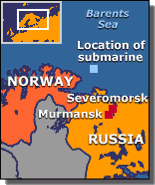|
Salvaging the Russian Atomic Submarine Kursk
Background The Naval Command instituted a search for her, and two US submarines and a Norwegian seismic research institute both reported two powerful explosions from the Barents Sea. The Russians read a third explosion at 2345 (11.45 PM) The following day, at 0436 (4.36 AM) the Cruiser Pyotr Velikiy (Peter the Great) using her sonar equipment, found a ship on the sea bed. It was reported to President Putin that the lost Kursk had been located. Rescue attempt The next day, Putin had agreed to seek foreign aid to help with this project. By the 17th. all attempts to have a mini-sub, seal with an escape hatch on Kursk had failed, and on the 20th. Norwegian and British divers had arrived on the scene, and the Norwegians unscrewed the valve of an escape hatch.
Signing of Contract This company formed in 1971, although a major operator of heavy lift cranes etc, had no experience in salvage operations. They had reduced their tender from $70 Million to $50 Million, with a $500 Million liability clause included if something went wrong. The contract gave them but 4 months to raise the sunken Kursk, sitting on the bottom of the Barents Sea at a depth of 108 metres. The Russian Submarine Cause of the explosion The Imperial Japanese Navy successfully used this propellant for their very efficient torpedoes throughout WW2, and reportedly did not have any accidents. The Salvage Operation. A giant saw was used to cut through this bow section, and although only expected to take a day or so, in fact, this saw broke down on numerous occasions, and 9 days were needed to chop off this piece of Kursk, which fell off and was left resting on the bottom. Two towers were placed, one each side of the central section of the remainder of the submarine, these rested on the sea bed, and were anchored by means of suction. To the base of one tower was attached a special carborundum wire cutting rope, it was then passed over the submarine, to be secured to the base of the second tower. This wire rope was hauled in by one tower, then in turn the second tower hauled it back, this in effect produced a back and forth cutting operation, and within 24 hours this device has succeeded in chopping the Kursk into two separate parts. A series of holes now needed to be drilled through the submarines pressure hull and inner hull to allow lifting clamps, attached to lifting cables to be put into place. Of course within a submarine, are a myriad of pipes, electrical wiring etc, after the initial holes were drilled, divers had to be sent down to clear away the piping and wiring which could only impede any clamps and lifting cables. 26 holes were drilled, and on the end of each lifting cable (each was made up of a bundle of 54 super strong steel ropes) was secured an anchor clamping mechanism. This operated like the simple spring loaded V anchor clamp used in the home to push through a hole drilled into a wall cavity, once the closed clamp is thrust through the drilled hole, the V sections close, and the anchor is locked into position by screwing up the clamp. These special anchor clamps produced for this salvage operation were designed to work in exactly the same way, but of course on a much larger scale. A special lifting barge, 140 metres by 36 metres ( 460 feet long by 120 feet wide ) had been built by Mammoet for this salvage operation. Underneath this barge was locked a lifting clamp, from which the 26 cables which had been attached to Kirsk could be individually monitored and controlled. The slack was taken up by the lifting cables and slowly the two separate parts of the giant submarine was winched to dock below the clamp section underneath the barge. It took but 15 hours to raise from the sea bed once all cables had been locked into position. It was Monday the 8th. of October 2001 Kursk was settled on the blocks on the dock floor, and the task of removing all the bodies for a decent burial, and the 22 Missiles was able to begin. The most stunning salvage operation ever in Maritime History had been successfully completed. Final tribute to Kursk A large group of dolphins followed these ships as if they were saying their last goodbye to the crew. |


